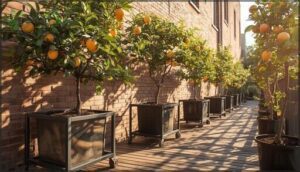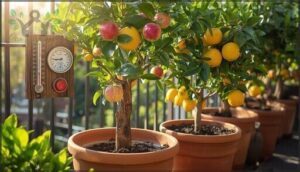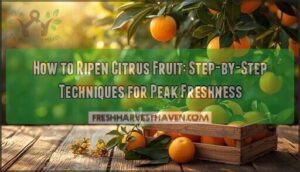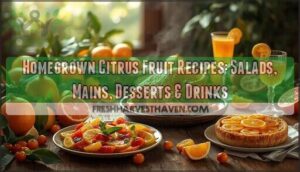This site is supported by our readers. We may earn a commission, at no cost to you, if you purchase through links.

A single dwarf Meyer lemon can pump out 40-60 fruits per season from a 15-gallon pot, while compact stone fruits and figs deliver harvests that rival their in-ground cousins. The secret lies in choosing the right varieties, nailing your soil blend, and understanding that roots confined to containers actually accelerate fruiting—trees focus energy on production rather than sprawling growth.
With disease-resistant genetics and proper care protocols, you’ll transform limited space into a self-sufficient fruit supply that defies conventional gardening wisdom.
Table Of Contents
- Key Takeaways
- Choosing Fruit Trees for Containers
- Selecting The Right Container
- Preparing Ideal Potting Soil
- Essential Care and Maintenance
- Optimizing Growing Conditions and Harvest
- Frequently Asked Questions (FAQs)
- How do you grow a fruit tree in a container?
- Can a fruit tree grow in a container?
- Can fruit trees grow in pots?
- What fruit trees grow in containers?
- How big should a fruit tree be in a container?
- When should you plant a fruit tree in a container?
- What is the easiest fruit tree to grow in a container?
- Do fruit trees grow well in pots?
- Can you grow fruit trees in 5 gallon buckets?
- Do fruit trees do well in pots?
- Conclusion
Key Takeaways
- Container-grown dwarf fruit trees can produce impressive yields—like Meyer lemons delivering 40-60 fruits per season from a 15-gallon pot—because confined roots redirect energy from sprawling growth into accelerated fruit production, often bearing within 1-3 years versus 5-7 for standard trees.
- Success hinges on selecting self-fertile, disease-resistant dwarf varieties (such as ‘Liberty’ apples with under 8% disease incidence or ‘Chicago Hardy Fig’ with 90% fungal stress survival) paired with containers at least 18-24 inches deep and a well-draining potting mix of 50-60% compost, 20-30% perlite, and 20-30% coco coir.
- Maintenance demands consistency—water 2-3 times weekly during growing season, feed every 6 weeks with balanced fertilizer, prune annually to remove one-third of growth (boosting fruit bud formation by 10-15%), and repot every 2-4 years with root pruning to prevent yield-crushing root binding.
- Winter protection is critical since container roots freeze at 3°F, requiring aggressive strategies like wrapping pots in 6-12 inches of straw mulch, moving to sheltered locations (which increases survival by 50%), and maintaining root zones at 25-27°F to prevent the crop obliteration that occurs when temperatures drop below 24°F during vulnerable bud stages.
Choosing Fruit Trees for Containers
Breaking free from traditional garden beds doesn’t mean sacrificing a harvest you can be proud of. Your container choices will shape everything from your daily watering routine to how much fruit you’ll actually pick, so you need varieties that won’t waste your time or space.
Let’s cut through the confusion and zero in on the fruit trees that’ll actually thrive in pots without demanding expertise you don’t have.
Best Dwarf and Semi-Dwarf Varieties
You’re not bound by space constraints anymore—dwarf fruit trees and semi-dwarf varieties let you cultivate abundant harvests in containers. Focus on compact citrus like Meyer lemon yielding 40-60 fruits per season, or stone fruit options such as Tropic Snow Peach maturing at 12-15 feet.
Consider these top container-grown fruit trees:
- Dwarf apple on M27 rootstock (under 6 feet)
- Semi-dwarf peach varieties like ‘Elberta’
- Dwarf figs producing within 2-3 years
- Kumquat trees yielding 20-30 fruits
- Mini-dwarf plums reaching 10-12 feet
Choosing fruit tree varieties adapted to confined root systems ensures sustained productivity and accelerated fruiting—usually within 1-3 years versus 5-7 for standard trees. For successful growth, understanding dwarf fruit trees is essential for your mini garden.
Self-Fertile Options for Small Spaces
Self-fertile varieties free you from needing multiple trees for pollination—dwarf peaches, nectarines, and figs achieve over 95% pollination without partners. Meyer lemon trees fruit in solitary containers, reaching 1–1.8 meters and producing within 2–3 years. Fuyu persimmon adapts brilliantly to container culture, yielding 15–20 fruits per season.
These compact, self-fertile dwarf varieties optimize container yield while transforming balconies into small space orchards.
When selecting trees, consider opting for self pollinating options to simplify the growing process.
Selecting Disease-Resistant Trees
Beyond fruitfulness, disease-resistant genetics shield your investment from common pathogens. Dwarf varieties like ‘Liberty’ and ‘Freedom’ apples show under 8% disease incidence, resisting scab and fire blight through sophisticated fruit breeding.
‘Chicago Hardy Fig’ achieves 90% survival under fungal stress, while ‘Improved Meyer Lemon’ boasts 92% resistance to root rot. Resilience testing proves these self-fertile variety champions excel in pest and disease control, minimizing fruit tree care headaches.
Selecting The Right Container
Your container choice sets the stage for your fruit tree’s entire life, so don’t just grab whatever’s cheap and available. The right pot gives your tree room to grow strong roots, keeps water from drowning them, and moves easily when you need to chase the sun or escape a freeze.
Let’s break down exactly what size, material, and features you need to set your tree up for success.
Minimum Size and Depth Requirements
Think of container size as your tree’s foundation—too small, and you’re choking its potential. For most dwarf fruit trees, you’ll need a pot diameter of at least 18–24 inches and a container depth of 18–24 inches to support a healthy root ball size and adequate soil volume.
Here’s what works for container gardening success:
- Start young trees in 5–7 gallon pots, then upsize gradually
- Match container size to your tree’s growth phase, not its final height
- Guarantee 15-gallon minimum (57 liters) for mature, fruiting trees
- Choose depth that allows root expansion without restriction
- Plan for 10–20 liter increases annually until maturity
Proper pot size gives you control over tree height while maximizing fruit yield in container fruit tree care.
Pot Materials and Drainage Needs
Your pot material directly impacts root health and watering demands. Plastic pots dominate container gardening because they’re lightweight and slow moisture loss by 30% versus terracotta containers, though they’ll need replacing every 2–4 years. Glazed ceramic options retain water better than unglazed, cutting watering frequency by 25%.
Whatever you choose, drill 4–6 drainage holes minimum—poor drainage kills more container fruit trees than any other mistake.
Mobility and Space-Saving Solutions
Moving your tree where sunlight shifts or frost threatens changes everything—around 60% of urban gardening enthusiasts already use rolling caddies for container mobility.
You’ll optimize small space gardening with these compact designs:
- Lockable caster wheels handle weights up to 200 pounds for mature dwarf fruit tree varieties
- Vertical stacking on tiered racks boosts patio plants production by 22% per square foot
- Columnar trees planted 18–24 inches apart multiply container fruit harvests in tiny balconies
Preparing Ideal Potting Soil
Your fruit tree won’t thrive in just any dirt—you need a mix that drains fast, feeds consistently, and keeps roots breathing. Garden soil is too heavy for containers, so you’ll be building your own blend or tweaking commercial options to get it right.
Here’s how to create the perfect potting soil that gives your tree the foundation it needs to actually produce fruit.
Well-Draining Potting Mix Recipes
You’ll break free from root rot when you nail your potting mix composition. This ratio prevents waterlogging while selecting the right soil foundation for vigorous growth.
For ideal soil structure and drainage materials, blend 50–60% quality compost with 20–30% perlite for aeration techniques, and 20–30% coco coir for water retention. Add 1–2 cups slow-release fertilizer per cubic foot.
| Mix Component | Volume (%) |
|---|---|
| High-quality compost | 50–60 |
| Perlite or vermiculite | 20–30 |
| Coco coir or peat moss | 20–30 |
| Slow-release fertilizer | 1–2 cups/cu. ft. |
| Optional worm castings | Small quantity |
Soil PH and Nutrient Balance
Your fruit tree’s soil pH levels control nutrient uptake—aim for 6.0 to 7.0 when mixing potting soil. Below 5.5 limits macronutrients and weakens roots, while above 7.0 blocks micronutrients like iron and zinc. Soil testing reveals imbalances before leaves yellow.
Consider these steps for pH management and fertilization success:
- Test your soil mix composition quarterly
- Add dolomitic lime for low pH
- Apply sulfur when pH climbs too high
Organic Matter and Fertilizer Choices
You’ll fuel strong growth with organic matter between 3% and 5%—it boosts nitrogen and cation exchange capacity in your potting soil. Composted yard waste, chicken litter, or OMRI-certified blends work well, while seaweed-fish emulsion feeds micronutrients every 10 days in spring. Time-release fertilizer like Osmocote simplifies nutrient cycling, supporting microbial activity that makes roots thrive.
| Amendment Type | Primary Benefit | Application Rate |
|---|---|---|
| Compost | Improves soil structure and CEC | 2–3 inches annually |
| Organic fertilizer (10-6-4) | Sustained nitrogen release | 1–8 lbs/year per tree |
| Seaweed-fish blend | Micronutrient boost | Every 10 days, spring |
Essential Care and Maintenance
Your container-grown fruit tree won’t thrive on autopilot—it needs consistent attention to water, nutrients, pruning, and health monitoring to produce quality fruit year after year. Think of maintenance as your tree’s lifeline, since potted trees can’t tap into ground resources like their garden-grown cousins.
Here’s how to keep your container fruit tree healthy, productive, and manageable through every season.
Watering and Feeding Frequency
Your container fruit trees won’t thrive on a guesswork schedule—water stress kills yields faster than neglect. During spring and early summer, you’ll need to water 2 to 3 times weekly, checking soil moisture before each irrigation timing decision.
Fertilizer schedules matter just as much: feed every 6 weeks from March through September using time-release fertilizer or water-soluble fertilizer with balanced nutrient profiles.
Pruning and Training Techniques
Once your feeding schedule locks in, you’ll need sharp pruning tools to shape compact trees that actually produce. Annual dormant pruning removes one-third of growth, boosting fruit bud formation by 10-15% while maintaining manageable size. Summer pruning and training techniques like espalier or cordon systems optimize your space—trained forms can triple yields per square foot.
- Prune timing matters: late winter for structure, summer for fruit coloring
- Fruit thinning prevents branch breakage and increases remaining fruit size by 10-20%
- Branch training with ties creates open canopies, improving airflow and light penetration
Pest and Disease Management
After pruning, you’re not done—pests and diseases can steal your harvest if you don’t stay vigilant. Aphids can slash photosynthesis by 30%, while brown rot destroys up to 85% of stone fruit during humid spells.
Your pest and disease management strategy starts with weekly inspections and organic solutions like kaolin clay, which blocks 90% of codling moth attacks. Integrated strategies combining biological controls, homemade recipes, and targeted pesticides keep your trees producing without toxic overkill.
Repotting and Root Pruning
Even disease-free trees fail when their roots strangle themselves—root binding can slash yields by 40%.
Root-bound trees can lose 40% of their yield, proving that even disease-free plants fail when their roots have nowhere to grow
You need to repot container-grown fruit trees every 2 to 4 years, trimming 10–30% of circling roots during dormancy. Refresh a third of your potting soil each time, and you’ll maintain root health that keeps productive trees thriving for 15–20 years in containers.
Optimizing Growing Conditions and Harvest
Getting your container fruit trees to thrive and produce a bountiful harvest isn’t about luck—it’s about understanding what they need and giving it to them on your terms. You’ll need to master the basics of light exposure, temperature management, and knowing exactly when your fruit is ready to pick.
Let’s break down the key conditions that’ll help you take full control of your container orchard’s success.
Sunlight and Temperature Requirements
Your fruit trees won’t just survive—they’ll thrive—when you meet their sunlight requirements and temperature control needs. Most varieties demand full sun, meaning at least 6 to 8 hours of direct light daily from southern or eastern exposure.
Warm weather climates within USDA zones 8–10 boost fruit quality, while subtropical types need consistent temperatures between 65–85°F to produce reliably across climate zones.
Overwintering and Frost Protection
When winter hits, your container fruit trees face a brutal reality: roots can freeze at 3°F, killing over half of unprotected trees. You need aggressive winter protection strategies to safeguard your investment.
Here’s your frost protection arsenal for overwintering fruit trees:
- Wrap containers in 6–12 inches of straw mulch to buffer temperature swings and boost root insulation
- Move pots to south-facing walls to cut wind exposure and increase winter dormancy survival by 50%
- Use foam covers to maintain root zones at 25–27°F, even when air plummets to -24°F
- Water heavily before freeze events to reduce root desiccation and winter injury by 30%
- Monitor bud stages closely—temps below 24°F during “first pink” can obliterate your crop
Cold hardiness isn’t optional. Trees in unheated garages show 40% better survival than exposed containers, proving that shelter equals freedom from freeze damage losses.
Harvesting Tips for Container-Grown Fruit
Timing separates mediocre harvests from peak fruit production in container gardening. You’ll boost fruit yield by picking citrus when heavy and bright-colored—no green remains—since it won’t ripen post-harvest.
For cherries and berries, wait for deep color and firm flesh. Harvest only when dry to prevent disease spread, then handle gently during post-harvest care to preserve quality and extend storage life.
Frequently Asked Questions (FAQs)
How do you grow a fruit tree in a container?
Like tending a ship in a bottle, growing fruit trees in containers demands attention to essentials: select dwarf varieties, use quality pots with drainage, provide well-draining soil, and maintain consistent water management for thriving root health.
Can a fruit tree grow in a container?
Yes, you can grow fruit trees in containers with impressive fruit yield. Container-grown fruit trees thrive when you control soil quality and root health, making potted fruit trees perfect for small-space container gardening.
Can fruit trees grow in pots?
Absolutely, fruit trees thrive in pots when you match container size to root management needs. Container-grown fruit trees depend on soil quality, watering techniques, and dwarf fruit tree selection for success in small spaces.
What fruit trees grow in containers?
You’ve got solid options for container gardening: dwarf apples, figs, Meyer lemons, and peaches thrive in pots.
Self-fertile varieties like ‘Bonanza’ peach or ‘Petite Negra’ fig deliver excellent fruit yield without cross-pollination hassles.
How big should a fruit tree be in a container?
Think your container limits a fruit tree’s growth? Root restriction naturally controls size—dwarf varieties reach 8-10 feet, semi-dwarf types 10-15 feet.
Container depth and dwarfing rootstock determine final mature tree size.
When should you plant a fruit tree in a container?
Plant container-grown fruit trees during dormancy—late fall or early spring—when soil temperatures reach 32°F to 45°F.
Consider your climate zones and chill hours to guarantee successful establishment before active growth begins.
What is the easiest fruit tree to grow in a container?
Fig trees rank among the easiest container-grown fruit trees, tolerating drought and demanding minimal maintenance.
Dwarf varieties adapt well to pots, resist common diseases, and produce fruit within one to two years.
Do fruit trees grow well in pots?
Yes, fruit trees grow well in pots when you choose dwarf varieties and provide proper tree root care.
Container-grown fruit trees thrive with quality pots, suitable container size, and well-balanced potting soil mix for successful container gardening techniques.
Can you grow fruit trees in 5 gallon buckets?
You can start container-grown fruit trees in 5-gallon buckets, but root binding will limit fruit yield and long-term health.
Using quality pots with proper container size ensures better water management and success with potting soil.
Do fruit trees do well in pots?
Absolutely. Container-grown fruit trees thrive when you match self-fertile variety options and semi-dwarf variety sizes to quality pots with proper container size, soil quality, and pot maintenance—giving you total control over tree health and placement freedom.
Conclusion
Where there’s a will, there’s a way—and growing fruit trees in containers proves you don’t need sprawling land to cultivate abundance. Your urban homestead starts with one pot, one tree, and the conviction that limited space won’t limit your harvest.
You’ve learned the mechanics: dwarf varieties, proper drainage, strategic pruning, and seasonal care that turns tight spaces into thriving orchards. Now comes the rewarding part—watching blossoms transform into fruit you’ll pluck straight from the branch.
- https://myperfectplants.com/blogs/blog/growing-fruit-trees-in-containers
- https://naturehills.com/blogs/garden-blog/best-fruit-trees-for-pots-planters-grow-anywhere
- https://resprout.com/small-fruit-trees-for-small-garden-designs-33-ideas/
- https://melissaknorris.com/podcast/growing-fruit-trees-in-pots-tips-for-success/
- https://www.akfoodpolicycouncil.org/wp-content/uploads/2024/09/SticklebackFarmReport-ContainerizedFruitTreesintheNorth.pdf









